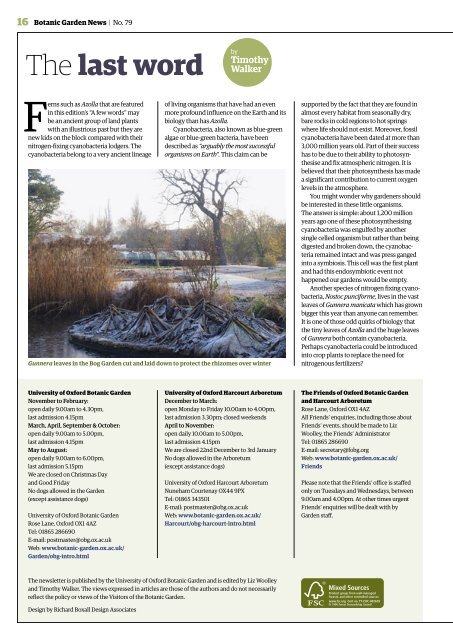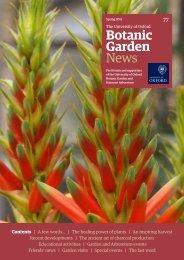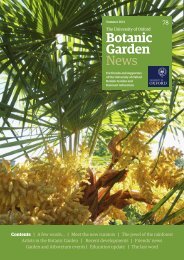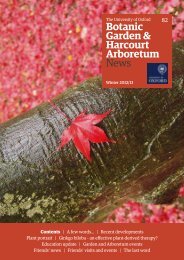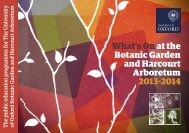Autumn/Winter 2011/12 - Harcourt Arboretum - University of Oxford
Autumn/Winter 2011/12 - Harcourt Arboretum - University of Oxford
Autumn/Winter 2011/12 - Harcourt Arboretum - University of Oxford
Create successful ePaper yourself
Turn your PDF publications into a flip-book with our unique Google optimized e-Paper software.
16<br />
Botanic Garden News | No. 79<br />
The last word<br />
by<br />
Timothy<br />
Walker<br />
F<br />
erns such as Azolla that are featured<br />
in this edition’s “A few words” may<br />
be an ancient group <strong>of</strong> land plants<br />
with an illustrious past but they are<br />
new kids on the block compared with their<br />
nitrogen-fixing cyanobacteria lodgers. The<br />
cyanobacteria belong to a very ancient lineage<br />
<strong>of</strong> living organisms that have had an even<br />
more pr<strong>of</strong>ound influence on the Earth and its<br />
biology than has Azolla.<br />
Cyanobacteria, also known as blue-green<br />
algae or blue-green bacteria, have been<br />
described as “arguably the most successful<br />
organisms on Earth”. This claim can be<br />
Gunnera leaves in the Bog Garden cut and laid down to protect the rhizomes over winter<br />
supported by the fact that they are found in<br />
almost every habitat from seasonally dry,<br />
bare rocks in cold regions to hot springs<br />
where life should not exist. Moreover, fossil<br />
cyanobacteria have been dated at more than<br />
3,000 million years old. Part <strong>of</strong> their success<br />
has to be due to their ability to photosynthesise<br />
and fix atmospheric nitrogen. It is<br />
believed that their photosynthesis has made<br />
a significant contribution to current oxygen<br />
levels in the atmosphere.<br />
You might wonder why gardeners should<br />
be interested in these little organisms.<br />
The answer is simple: about 1,200 million<br />
years ago one <strong>of</strong> these photosynthesising<br />
cyanobacteria was engulfed by another<br />
single celled organism but rather than being<br />
digested and broken down, the cyanobacteria<br />
remained intact and was press ganged<br />
into a symbiosis. This cell was the first plant<br />
and had this endosymbiotic event not<br />
happened our gardens would be empty.<br />
Another species <strong>of</strong> nitrogen fixing cyanobacteria,<br />
Nostoc punciforme, lives in the vast<br />
leaves <strong>of</strong> Gunnera manicata which has grown<br />
bigger this year than anyone can remember.<br />
It is one <strong>of</strong> those odd quirks <strong>of</strong> biology that<br />
the tiny leaves <strong>of</strong> Azolla and the huge leaves<br />
<strong>of</strong> Gunnera both contain cyanobacteria.<br />
Perhaps cyanobacteria could be introduced<br />
into crop plants to replace the need for<br />
nitrogenous fertilizers<br />
<strong>University</strong> <strong>of</strong> <strong>Oxford</strong> Botanic Garden<br />
November to February:<br />
open daily 9.00am to 4.30pm,<br />
last admission 4.15pm<br />
March, April, September & October:<br />
open daily 9.00am to 5.00pm,<br />
last admission 4.15pm<br />
May to August:<br />
open daily 9.00am to 6.00pm,<br />
last admission 5.15pm<br />
We are closed on Christmas Day<br />
and Good Friday<br />
No dogs allowed in the Garden<br />
(except assistance dogs)<br />
<strong>University</strong> <strong>of</strong> <strong>Oxford</strong> Botanic Garden<br />
Rose Lane, <strong>Oxford</strong> OX1 4AZ<br />
Tel: 01865 286690<br />
E-mail: postmaster@obg.ox.ac.uk<br />
Web: www.botanic-garden.ox.ac.uk/<br />
Garden/obg-intro.html<br />
<strong>University</strong> <strong>of</strong> <strong>Oxford</strong> <strong>Harcourt</strong> <strong>Arboretum</strong><br />
December to March:<br />
open Monday to Friday 10.00am to 4.00pm,<br />
last admission 3.30pm; closed weekends<br />
April to November:<br />
open daily 10.00am to 5.00pm,<br />
last admission 4.15pm<br />
We are closed 22nd December to 3rd January<br />
No dogs allowed in the <strong>Arboretum</strong><br />
(except assistance dogs)<br />
<strong>University</strong> <strong>of</strong> <strong>Oxford</strong> <strong>Harcourt</strong> <strong>Arboretum</strong><br />
Nuneham Courtenay OX44 9PX<br />
Tel: 01865 343501<br />
E-mail: postmaster@obg.ox.ac.uk<br />
Web: www.botanic-garden.ox.ac.uk/<br />
<strong>Harcourt</strong>/obg-harcourt-intro.html<br />
The Friends <strong>of</strong> <strong>Oxford</strong> Botanic Garden<br />
and <strong>Harcourt</strong> <strong>Arboretum</strong><br />
Rose Lane, <strong>Oxford</strong> OX1 4AZ<br />
All Friends’ enquiries, including those about<br />
Friends’ events, should be made to Liz<br />
Woolley, the Friends’ Administrator<br />
Tel: 01865 286690<br />
E-mail: secretary@fobg.org<br />
Web: www.botanic-garden.ox.ac.uk/<br />
Friends<br />
Please note that the Friends’ <strong>of</strong>fice is staffed<br />
only on Tuesdays and Wednesdays, between<br />
9.00am and 4.00pm. At other times urgent<br />
Friends’ enquiries will be dealt with by<br />
Garden staff.<br />
The newsletter is published by the <strong>University</strong> <strong>of</strong> <strong>Oxford</strong> Botanic Garden and is edited by Liz Woolley<br />
and Timothy Walker. The views expressed in articles are those <strong>of</strong> the authors and do not necessarily<br />
reflect the policy or views <strong>of</strong> the Visitors <strong>of</strong> the Botanic Garden.<br />
Design by Richard Boxall Design Associates


